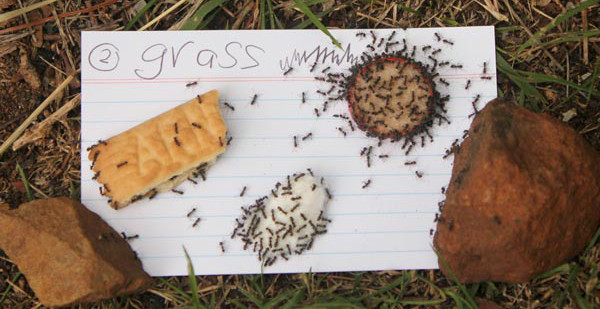Launched in May 2014, a scientific initiative is now expanding to ask primary school students from around the country to take part in serious ecological research – by studying ants.
School of Ants is a citizen science project examining the diversity, distribution and diet of ants in and around our populated environments.
The project was initiated by entomologist Dr Kirsti Abbott, who trialled the project with a group of primary school students at a Melbourne primary school. She now coordinates the project within the Insect Ecology lab at the University of New England, with educators and volunteers.
The project is a node of the original US-based project of the same name that started in 2011.
“It’s where ecologists, educators and writers collaborate with the public, and it’s also happening in Italy. That the whole project is primarily based outside the classroom, and empowers kids to build on what they already know about their surrounding environment, including their school grounds, is one of its strengths as an environmental education initiative,” said Abbott.
Yet all of this only serves to beg the question, ‘But why ants?’
“Most of us are aware of biodiversity on a large scale; we can identify a koala, a blue tongue lizard, a snow gum. But few people understand or appreciate the importance of the ecological roles of invertebrates, including ants. The School of Ants project aims to remedy this,” she responded.
There are more than 1300 species of ants in Australia, more than all mammals and reptiles put together. Ants provide soil enrichment and oxygenation while turning over soil; they remove carrion and other waste from roads, and across our towns and cities; they farm honey producing insects, some of which are serious agricultural and environmental pests; and they impact on humans directly too.
The Red Imported Fire Ant (RIFA) that is established in Brisbane, and recently found at Port Botany in Sydney, is a serious threat to our agriculture and economy. Its sting is extremely painful, and colonies of RIFA can overcome pets and other wildlife easily. It is one of six invasive ant species established in Australia with the capacity to really change our Australian environment for the worse.
“The School of Ants project is simple enough for all age groups to participate”, said Abbott.
“All you have to do is place five cardboard squares on a paved or concreted area, and five on a green or grassy area, all of them with a piece of common deli frankfurt, a quarter of an Arnott’s Scotch finger biscuit and a cotton wool all soaked in sugar solution. After an hour you count the ants on each food source, collect the ants into a ziplock bag and send the whole lot to me at UNE.”
Back in the lab, the School of Ants team identifies the ants, records their identity in their database and places the specimens in the UNE Zoology Museum insect collection. The patterns of diversity and distribution become more meaningful as more samples are sent in.
This year, Abbott is taking the project on tour. All around Australia, students and families will be collecting data on ants in their schoolyards and backyards every month. In fact, you can join in by visiting the website and registering.
“Having citizens collect data synchronously across the country is a powerful way of observing broad spatial and temporal patterns of biodiversity; something one researcher could not achieve alone”, Abbott observed.
“School of Ants on tour in 2015 means that students at schools in rural, remote and invasive ant hotspots not only become scientists once a month as part of a nation-wide research project. They get to spend a day learning about the little things that run the world, engaged in science, using microscopes, collecting and analysing data, observing ant colonies, printing t-shirts, and playing ant games.”
Over the coming year, Abbott will travel to Brewarrina, Gympie, Longreach, Alice Springs, Cairns, Gippsland and more towns to deliver an educational experience for students with limited access to projects such as this.
The project has so far received samples from more than 35 locations across NSW, QLD, TAS and VIC. Ants from the genera Iridomyrmex, Rhytidiponera and Camponotus seem to be the most common at food within the hour and, since the project’s inception in Australia, the frankfurt attracts most of the ants.
However, these results are not entirely unexpected since ants in these genera are known to be common and dominant ground foraging species in Australia.
Qualifying this consistent pattern, Abbott explains, “But just this month we’re seeing some changes in the food type ants are recruiting to”.
“There are some fabulously weird and wonderful looking ants being sent in,” enthused Abbott. “Identification of the specimens in citizen science projects like this can be slow going, but the taxonomy is all the more important because there are so many more species to identify.”
Register yourself or your young ones at the School of Ants website to collect ants and learn more about the wildlife in your own backyard.


